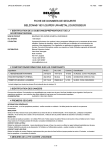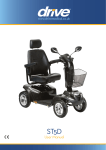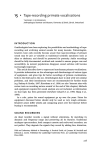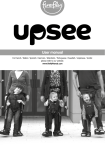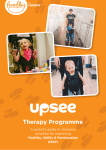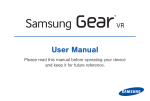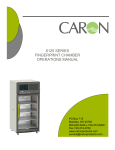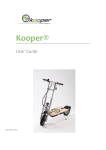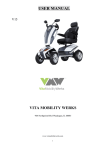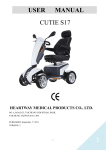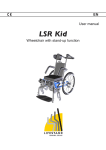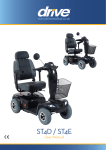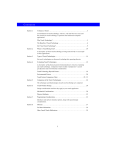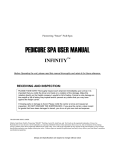Download User manual
Transcript
User manual For French / Italian / Spanish / German / Mandarin / Portuguese / Swedish / Japanese / Arabic please refer to our website. www.fireflyfriends.com Please read all instructions carefully before using your Playpak. All instructions can also be found on our website www. fireflyfriends.com/playpak along with videos, diagrams and FAQ’s. Table of Contents 01 Intended use 02 Declaration of conformity 03 Terms of warranty 04 Safety information 05 Cleaning and care information 06 Daily product inspection 07 Re-issuing Firefly products 08 Product servicing 09 Instructions for use: 10 How to know whether Playpak is suitable for your child 11 How to unpack and pack your Playpak 12 How to use your Playpak – the Playpak Therapy Guide 13 Technical information 14 Frequently asked questions SECTION 1. Intended Use Playpak is a portable activity kit that lets kids develop through play. This lightweight bag unfolds to produce an entire activity centre that has been designed for special needs babies and kids ranging from birth to approximately 48 months and Gross Motor Function Classification Scale (GMFCS) levels I-V, depending on their level of physical development. Inside you will find rolls, wedges and supports, (designed by clinical experts) that stick together in dozens of ways and let your child tackle different developmental postures. Playpak also comes with a handy online therapy guide, featuring advice and animated easyto-use instructions that show you how to use each clever little piece to create different lying and sitting positions, as well as how to perform our recommended developmental games with your child. You can take a look at an overview of the Guide in Section 9.3, or watch online at www.fireflyfriends.com/playpak. The importance of early development through play Every baby comes into the world with limited abilities, which is why the first three years of a child’s life are the most important period of development. For some babies however, their new born limitations are not simply overcome by time. If a child’s development is delayed for whatever reason, it means they are likely to acquire skills more slowly, or the extent to which they master a skill may vary. SECTION 3. Terms of warranty UK / ROI: Goods can be returned to us for warranty repair or replacement up to 12 months from receipt. In all cases, it is the customer’s responsibility to ensure the goods being returned are suitably packaged, preferably in the original packaging. 16.If in any doubt about your ability to use Playpak safely, or if any parts should fail, please cease using the product immediately and contact Firefly Customer Services on UK 0800 318265 or ROI 1800 626020. Children with developmental delay, just like any other children, learn through play. Fun through play can actually encourage children to work harder on therapy goals. International Customers: Goods can be returned to us for warranty repair or replacement up to 12 months from receipt. Please contact us to obtain a case reference ID as per the International Returns procedure. The customer is responsible for the cost of returning the goods. Once returned to us we will repair or replace your goods and return them to you within 14 days. Bag/Mat - The Playpak bag/mat can be individually placed into the washing machine and washed at 30ºC. - Whilst line drying is recommended, the Playpak bag/mat can be tumble dried at a low temperature. - Do not dry clean. - Do not bleach. - Do not iron. - Wash separately from other garments to avoid colour run. - Staining should be removed as quickly as possible with an absorbent cloth, towels or a sponge. Routine soap and warm water sponging is effective for ordinary soiling and minor spills. Be careful not to saturate the fabric as this will cause the stain to spread. - Antiseptic cleaning agents can be used on more stubborn stains. These may require a safe solvent such as Isopropyl Alcohol or Mineral Spirit. Ensure that cleaning products are fully removed. Playpak is designed to assist your child to improve their physical, cognitive, sensory and pre-speech communication abilities. Enabling play in three key therapeutic positions forms the basis for later abilities - back lying (supine), tummy lying (prone) and floor sitting (long sitting). With Playpak you can “mix and match” positions and activities for your child using the various components, ensuring the best possible developmental start. Changing positions is important, as this is what allows your child to progress independently at a later stage. The aim is to allow your child to develop a variety of movement skills, as well as building strength and coordination. Family participation Playpak lets you as a family play a bigger part in your child’s therapy too, and that matters a lot. Research shows that early intervention programmes that allow therapists and families to work together, like Playpak does, make an even bigger impact on a child’s development. Regular practice is important when training the brain to make important early connections. For some children, developmental games and programmes, such as the ones suggested with Playpak, can also help reduce irritability and improve physical, sensory, communication and independence skills. Therapists and families in partnership You may find your child likes some positions more than others, or some positions may not be medically recommended for your child to use. It’s important that, if in any doubt, you take advice from your therapist(s) about the best positions to place your child in. This may depend on whether your child’s muscles are tight (high tone) or floppy (low tone), their level of development or tolerance for certain positions. Some positions may need to be avoided for medical reasons, and others will need to be encouraged, even if your child is not keen at the start. SECTION 2. Declaration of conformity James Leckey Design Ltd, as manufacturer with sole responsibility for the Firefly brand, declares that Playpak conforms to the requirements of the 93/42/EEC Guidelines and EN12182 Technical Aids for Disabled Persons, General Requirements and Test Methods. In all cases, it is the customer’s responsibility to ensure the goods being returned are suitably packaged, preferably in the original packaging. SECTION 4. Safety information 1.Always read user instructions fully before use. 2.Do not modify your Playpak or use components other than Firefly recommended components with it at any time. Playpak should not be used if any of its components are faulty. 3.Always use the bag/mat as a floor mat base of support and never use the other components on their own. 4.Remove shoulder strap before product use 5.Playpak has been designed for indoor use and when not in use should be stored carefully in a dry place that it not subject to extreme temperatures. 6.Always use Playpak on a level surface. 7.Carry out any positional adjustments and ensure that all Velcro is fully affixed before use – ensure your child is secure at all times. 8.Do not force positions with your child as you could harm them. Ensure that, for each activity you do with your child, you are using the correct and recommended components – for advice on this, see Section 9.3. 9.To avoid any rubbing or grazing of the skin, ensure that Velcro is placed away from the child at all times. If you notice any ongoing irritation as a result of using Playpak, discontinue use. 10.Do not leave your child unattended whilst using Playpak. 11.Playpak complies with fire safety regulations in accordance with EN1021-1. However the product should be kept away from naked flames. 12.Clean the product regularly in accordance with Section 5 of these user instructions. Do not use abrasive cleaners and do not dry clean. Carry out maintenance checks on a regular basis to ensure your product is in good working condition. 13.Take care not to nip fingers or trap clothing when opening and closing zippers on bag – follow Section 9.2 for advice. 14.Ensure that your child is physically suitable for Playpak by noting the technical information in Section 10. 15.Failure to follow the user instructions may put you and/ or your child at risk. SECTION 5. Cleaning and care information Components - All upholstery can be removed from foam components, placed into the washing machine and washed at 40ºC. - Whilst line drying is recommended, the Playpak components upholstery can be tumble dried at a low temperature. - Do not dry clean. - Do not bleach. - Do not iron. - Wash separately from other garments to reduce risk of colour run. - Staining should be removed as quickly as possible with absorbent cloth, towels or a sponge. Routine soap and warm water sponging is effective for ordinary soiling and minor spills. Be careful not to saturate the fabric as this will cause the stain to spread. - Antiseptic cleaning agents can be used on more stubborn stains. These may require a safe solvent such as Isopropyl Alcohol or Mineral Spirit. Ensure that cleaning products are fully removed. Velcro To ensure that Velcro remains ‘sticky’, remove any ‘fluff’ build up on a regular basis by using either a dry toothbrush, wire cat/dog brush or an adhesive lint roller. SECTION 6. Daily product inspection To ensure that Playpak is safe, we recommend that various checks are carried out before use. The recommended checks are detailed below: - Ensure that the ‘stickiness’ of the Velcro has not been compromised by a build-up of ‘fluff’. Use a dry toothbrush, wire cat/dog brush or an adhesive lint roller to remove any ‘fluff’ from the bag/mat and components on a regular basis. - Before you begin any activity with your child, ensure that you have all of the necessary components required to support them safely during that activity. Section 9.1 Instructions for use If in any doubt of the continued safe use of your Firefly product or if any parts should fail, please cease using the product and contact our customers services department as soon as possible. How to know whether Playpak is suitable for your child SECTION 7. Re-issuing Firefly products Ensure the product has been cleaned thoroughly in accordance with Section 5 of this manual. Ensure a copy of the user manual is supplied with the product. If in any doubt of the continued safe use of your Firefly product or if any parts should fail, please cease using the product and contact our customer service department as soon as possible on UK 0800 318265 or ROI 1800 626020. Every baby comes into the world with limited abilities, which is why the first four years of a child’s life are the most important period of development. For some babies however, their new born limitations are not simply overcome by time. If a child’s development is delayed for whatever reason, it means they are likely to acquire skills more slowly, or the extent to which they master a skill may vary. SECTION 8. Product servicing Servicing of all Firefly products should only be carried out by technically competent persons who have been trained in the use of the product. This service is free of charge within the warranty period assuming the product has been used for the appropriate intended use. If the product falls outside of the warranty period, repairs will be chargeable. We may need to have the product returned to Firefly for further inspection which may incur a small fee for transportation. For all service related issues contact the Firefly customer service team on UK 0800 318265 or ROI 1800 626020. Children with developmental delay, just like other children, learn through play. Fun through play can actually encourage children to work harder on therapy goals. Playpak is a lightweight, portable entire activity centre that has been designed for special needs babies and kids ranging from birth to approximately 48 months and Gross Motor Function Classification Scale (GMFCS) levels I-V, depending on their level of physical development. Its purpose is to assist your child to improve their physical, cognitive, sensory and prespeech communication abilities by enabling play in three key therapeutic positions which form the basis for later abilities - back lying (supine), tummy lying (prone) and floor sitting (long sitting). It consists of rolls, wedges and supports, (designed by clinical experts) that stick together in dozens of ways and let your child tackle different developmental postures. Playpak also comes with a handy online therapy guide, featuring advice and animated, easy-to-use instructions. These show you how to use each clever little piece to create different sitting and lying positions, as well as how to perform all the recommended developmental games with your child. You can take a look at an overview of the Guide in Section 9.3, or watch online at www.fireflyfriends.com/playpak. You may find your child likes some positions more than others, or that some positions may not be medically recommended for your child. It is important that if in any doubt, you take advice from your therapist(s) about the best positions to place your child in. This may depend on whether your child’s muscles are tight (high tone) or floppy (low tone), their level of development or tolerance for certain positions. Some positions may need to be avoided for medical reasons, and others will need to be encouraged, even if your child is not keen at the start! Section 9.2 How to unpack and pack your Playpak When opening the box, take care not to cut through it as you may damage some of the parts contained inside. Remove Playpak from the box. Unpacking Playpak will arrive ready for use. Opening and unpacking is easiest when it is laid flat on the floor. Simply lift up the flap of the bag and unzip down sides by pulling on the orange Firefly zip pulls. Take care not to nip your fingers in the zips. Fold flat by gently pulling apart the Velcro on the two small side flaps to reveal the rolls and wedges. We recommend that you remove the shoulder strap using the two hooks on either end of the strap before using your Playpak, as it could create an uneven surface underneath the floormat. With your Playpak, you will receive: 1x Bag/Mat The underside of your Playpak bag has a strip of non-slip fabric to help prevent the mat from sliding on smoother floor surfaces. 1 Rolls, (1x long and 1x short) These rolls can be used on their own or with other support elements to provide just the right level of support. 2 Positioning Strap Use this versatile strap in addition to the rolls for extra support when needed at the front, sides or back. 3 Head/Tummy Support Can be used on its own to support head or trunk, or with other components for extra positioning possibilities. 4 Horseshoe Sitting Supports, (1x large and 1x small) These profiled cushions are designed to give your child lower and upper back support, while allowing the hands to be free for play and function. When used in conjunction with the other elements, additional front, rear or side support can be increased. The bag is unzipped and unfolded as instructed above. The colourful reverse floor mat side of the bag is covered with a cloud-shaped piece of “fluffy” Velcro, to which all the components can be quickly, easily and securely attached/removed. As well as this, there are also loops on all sides of the mat, to which you can attach you child’s favourite toys. You are now ready to start using your Playpak! Keep any polythene bags away from children. 2 Always use this mat on a level surface as a floor mat base of support, and never use the components on their own. 1 4 3 1 Packing There are a number of different ways to pack Playpak efficiently, and you will find the best way for you with practice. This is our recommended technique for efficient packing: 1 Use the Velcro on the two small side flaps to stand the flaps up. This will give you an accurate idea of how much space you have. 2 Place the large red horseshoe sitting support on to the mat first. The back of the support should be sitting flush with the folding edge of the bag. 3 Place the small green horseshoe sitting support in the middle of the large red one. 4 The blue head/tummy support will sit neatly on top of the green horseshoe support, along with the positioning strap 5 Place the long orange roll at the other folding edge of the bag, as shown, and place the short yellow roll on top of it, (you may need to fold the long orange roll in half) 6 Zip up this side of the bag using the orange Firefly zip pull, being careful not to nip your fingers. 7 ip up the other side of the bag, then pull the Z flap over and push down so that the Velcro ‘sticks’ securely. 8 Attach your shoulder strap using the hooks on either end of the straps. You are ready to go! 3 1 7 2 4 5 6 Section 9.3 How to use your Playpak – the Playpak Therapy Guide As mentioned previously, your Playpak also comes with a handy online therapy guide, featuring advice and animated, easy-to-use instructions. These show you how to use each clever little piece to create different sitting and lying positions, as well as how to perform all the recommended developmental games with your child. You can take a look at an overview within this section, or watch online at www.fireflyfriends. com/playpak You may find your child likes some positions more than others, or that some positions may not be medically recommended for your child to use, and for this reason, it’s important that, if in any doubt, you take advice from your therapist(s) about the best positions to place your child in. This may depend on whether your child’s muscles are tight (high tone) or floppy (low tone), their level of development or tolerance for certain positions. Some positions may need to be avoided for medical reasons, and others will need to be encouraged, even if your child is not keen at the start! It is also important to remember that if your child is showing signs of fatigue, it is time to stop your session and take a rest. Before you start to use Playpak, ensure components are secure and check all Velcro for any sign of damage, wear or tear. If there are signs of damage, do not use the product and phone customer services for advice. Start with back lying, then tummy lying, then floor sitting to follow the developmental sequence. Back Lying Why? The most fundamental and secure position from which to work on the physical, cognitive, sensory, and communication skills that provide the building blocks to more complex skills. Physical goals Children will benefit from strengthened neck, tummy, shoulder and hip flexor muscles because they have to lift their heads, arms and legs up against gravity. Cognitive goals When children bring their hands and feet together to explore, they learn about their own body parts and their relationship to each other. This forms the basis of body awareness and co-ordination. Sensory goals When lying on their backs it is easiest for children to focus their eyes on a dangling object. First they learn to follow it through quarter of a circle using just their eye movements, then through half a circle moving their head as well as eyes. As they become aware of their own hands and feet and take them to their mouths, their handeye coordination and fine motor skills are developing. Communication goals In this position it is easiest for children to become more aware of the people and objects around them. They’ll develop skills in paying attention, concentrating and turn-taking – all early stages of communication, language and speech. Back Lying Activity Suggestions 1 Hold a brightly coloured object (such as a scarf or pom-pom) about 30-40cm above your child’s face. Move the object from left to right through a quarter circle, then back, going slowly enough so baby’s eyes can follow it. Make the task a little more difficult by holding the object 40-50cm from her face and moving it through a semi-circle to encourage head movements. To help her learn new words, bring the toys you use into her line of vision before you name them. 3 With the same set-up, use the hip positioning strap to stabilise your child’s hips. Encourage her to reach across her body with her left hand to a toy on the right side, and vice versa. Place your hand behind her shoulder to assist if necessary. To make this a bit more difficult, remove the pelvic strap and move the toy a little further out of reach. Your child should need to shift her weight at her hips to reach the toy. This is a building block for the transition of rolling later on. 2 Encourage your child to bring her hands together on her chest. Place your hands behind her shoulders to encourage her arms to come forward. 4 Hold onto your child’s feet and help her to kick or “bicycle” her legs. This helps to strengthen tummy, legs and feet, and the reciprocal movement is one which is needed for later weight bearing or movement. 5 Bring your child’s hands and feet together. This midline position is good for symmetry, and baby is beginning to learn to use both sides of her body together. 6 As she can see your face easily, it is also a good opportunity to play peek-a-boo games and to sing rhymes with actions to help to develop her attention, for example “this is the way we wash our hands”, “the wheels on the bus” etc. Copy any sounds she makes back to her. Change the tone (intonation) and emphasis (inflection) of your own voice to link to the movements and to help her focus on the key words. 7 8 To encourage rolling, place baby midway between back lying and side lying. Encourage her to reach or kick for a toy so she can begin to roll onto her tummy in a controlled, fluid manner. Help her to move at first by moving her hips or legs, while she works to turn her shoulders. Make rolling a little more difficult by holding the lower half of the body steady using your hands or the positioning strap. Encourage the child to roll leading with her top half. Position toys just out of reach of baby. As her top half turns, allow her lower half to follow. Tummy Lying Activity Suggestions Tummy Lying Why? Tummy time is a difficult position for children as it means they have to struggle against gravity to lift their heads, however it’s especially important when developing and strengthening muscles. Remember to use simpler activities at first. Physical goals Lifting a child’s head and shoulders up against gravity helps to strengthen the straightening (extensor) muscles of the trunk. This is helpful for children with floppy (low tone) muscles. It is also an important foundation for the development of sitting. Cognitive goals As children learn to hold their heads up and prop on her forearms, their shoulders and arms are giving sensory feedback about their position in relation to the child’s body and the environment. As this works together with her eyes and their environment when reaching for toys, their spatial awareness is also developing. Sensory goals With reasonable head control, children will be able to play for some time in this position, continuing to strengthen their muscles, while exploring their environment and looking around. Communication goals Tummy lying may make it more difficult for baby to make sounds (vocalise), as their chest is compressed in this position. However communication goals are a good way to provide the motivation they need to practice this important developmental position. 1 Encourage your child to lift her head up – use a favourite toy to motivate her. To make this a little more difficult, try moving the toy slowly from side to side, so baby has to turn her head to follow it. Sing your child’s favourite songs and action rhymes to encourage him to look up at you. Change the tone (intonation) and emphasis (inflection) of your own voice to link to the movements and to help your child to focus on the key words. To help her learn new words, remember to bring any toys you use into her line of vision before you name them. 2 Encourage baby to “push-up” on straightened (extended) arms with open hands. This will strengthen her shoulder and upper trunk, and encourages weight bearing through her arms – a building block for four-point kneeling. It is also a very early building block for finer motor skills which depend on stability at the shoulder for the control needed. Sing your child’s favourite songs and action rhymes to encourage her to look up at you. Change the tone (intonation) and emphasis (inflection) of your own voice to link to the movements and to help your child to focus on the key words. To help her learn new words, remember to bring any toys you use into her line of vision before you name them. Floor Sitting 3 While baby has her head lifted up, encourage her to reach and grasp with one hand, then the other. This helps to develop trunk and lower spine extension – the start of the lumbar curve. The weight shift involved when using one hand at a time uses more complex muscle control – this helps later for sitting up and using the arms against gravity. 5 To encourage rolling, place baby midway between back lying and side lying. Encourage her to reach or kick for a toy so she can begin to roll onto her tummy in a controlled, fluid manner. Help her to move at first by moving her hips or legs, while she works to turn her shoulders. 4 Place your child in a curled up position on her tummy, ensuring her airway is clear. Make sure her hips, knees and ankles are bent (flexed), and place a roll firmly behind her feet. Show her an exciting toy, and she should start kicking, pushing herself forward. Tickle baby’s feet, and place them against the roll to encourage movement. This is a building block for commando (belly) crawling and four point crawling. 6 Make rolling a little more difficult by holding the lower half of the body steady using your hands or the positioning strap. Encourage the child to roll leading with her top half. Position toys just out of reach of baby. As her top half turns, allow her lower half to follow. Why? Sitting is considered a vital part of the developmental sequence because of the other skills which are based upon its foundation. Physical goals The main physical purposes of sitting are to stabilise the trunk and pelvis allowing the arms and hands to be free. This allows handling of objects, exploration, increased learning opportunities and interaction with the environment. Children can be encouraged to reach, grasp and release toys, bang blocks together, and throw things! Cognitive goals Sitting up helps children to realise that their environment is three dimensional. It’s also a more social posture – the majority of us communicate with each other from an upright posture, whether sitting or standing. Sensory goals With head control developing well, and when securely supported in a sitting posture, a child’s hands are free to explore a much greater range of textures, shapes, and sizes. Communication goals The social posture of sitting is an excellent position for focusing on introducing new words and phrases, especially describing words and action words. If your child’s floor sitting skills are still developing, remember that you may have to provide more support if the goal is learning new words. Section 10 Technical information Floor Sitting Activity Suggestions 1 2 Technical Table Age: Birth to 48 months Encourage your child to reach for toys while sitting. At first, place toys within easy reach and encourage grasping, moving from hand to hand, banging together, and throwing. Encourage your child to reach for toys while sitting. Make this play more difficult by placing objects a little way in front of baby, so she has to reach further forward to get them. Ask your child to reach for a different toy each time from a choice of 2 or 3, (for example, “where’s the ball?”). Change the tone and emphasis of your own voice to link to the movements and to help your child to focus on the key words. 3 1. Folded Bag 2. Unfolded Bag, (Floor mat) 3. Long roll 4. Short roll 5. Positioning strap Length 44cm/17in 134cm/53in 52cm/20in 28cm/11in 66cm/26in Width 49cm/19in 75cm/30in 9cm/3.5in 9cm/3.5in 8cm/3.1in Depth 15cm/5.9in NA 7cm/2.8in 7cm/2.8in NA 6. Head/tummy support Length 22cm/8.7in Width 26cm/10in Depth 25cm/9.8in Angle 6.5° 7. Large horseshoe support 8. Small horseshoe support Height 11cm/4.3in 7cm/2.8in Depth 10cm/3.9in 9cm/3.5in Min Seat Width 20cm/7.9in 20cm/7.9in Max Seat Width 25cm/9.8in 25cm/9.8in 4 u Clo Cl ou cm /3 1.5 in at Flo ma 4 t 13 3in /5 cm or m 75 n 0i /3 cm To help your child learn new words, remember to bring any toys you use into her line of vision before you name them. 80 or To help your child learn new words, remember to bring any toys you use into her line of vision before you name them. Hold a brightly coloured object 12-15” in front of your child’s face. Move slowly in a semi-circle. She will learn to turn her head in sitting, using her hip and pelvic muscles to keep her steady against gravity, and using trunk muscles to rotate from one side to another. d Combined Horseshoe Height: 18cm/7.1in Flo While sitting place toys to either side, encouraging reaching out to the side. All of these movements help to develop neck and trunk muscles, eye-hand co-ordination and weight shift. 5in 31. m/ 0c d8 Section 11 Frequently Asked Questions What is the difference between Playpak and Leckey’s Early Activity System, (EAS)? however if you are in any doubt, consult your therapist for advice. How many times per week should I use Playpak? My child has a visual impairment. Can they use Playpak? Playpak has taken the concept of Leckey’s EAS and simplified it for regular use within a family environment. Portability, affordability and development through family participation were key objectives when designing Playpak. An online animated Therapy Guide is available, designed to help families take part in a variety of everyday back lying, tummy lying and sitting activities with their child. For more information on the different positions and activities that can be achieved with Playpak, go to www.fireflyfriends.com/ playpak to watch the animated Playpak Therapy Guide, or to Section 9.3 of this booklet. If your child enjoys and is happy achieving a variety of positions using Playpak, then a daily therapy routine incorporating Playpak time may be helpful. Yes. Playpak provides a safe way for a child with visual impairment to play and develop. In a supportive position, with their hands free to explore their surroundings, it’s a good idea to incorporate the use of sensory toys to develop your child’s sensory and perceptual awareness. The EAS continues to be more clinically-focused and larger product, containing components which facilitate more complex therapeutic positions, such as side-lying and four-point kneeling. The Activity Development Programme is a comprehensive printed booklet that comes with the purchase of an EAS. It is designed to allow therapists to work through activities with parents, as part of an early development programme. You may find your child likes some positions/ activities more than others, and these will most likely be the ones they are happy and able to do for longer. How do I know if Playpak is suitable for my child? Playpak has been designed for special needs babies and kids ranging from birth to approximately 48 months and Gross Motor Function Classification Scale (GMFCS) levels I-V, depending on their level of physical development. In its most basic function, Playpak facilitates back lying, which is the most fundamental and secure position from which to work on physical, cognitive, sensory, and communication skills that provide the building blocks to more complex skills for your child. As a result, Playpak should be suitable for them to use, How long should I use Playpak for each session? This may depend on whether your child’s muscles are tight (high tone) or floppy (low tone), their level of development, or tolerance of certain positions. Some positions may need to be avoided for medical reasons, and others will need to be encouraged, even if your child is not keen at the start. Some positions may not be medically advisable for your child. It is important that, if in any doubt, you take advice from your therapist(s) about the best positions in which to place your child and for how long. If your child is in any discomfort, take them out of that position and either have a rest or try something a little easier. Bear in mind that the time of day and your child’s mood will also have an effect on how long it will be appropriate to use Playpak for each session. Regular practice is important when training the brain to make important early connections. Taking part in developmental games and programmes, such as the ones suggested with Playpak on a daily basis, can also help reduce irritability and improve physical, sensory, communication and independence skills. What activities should we do with Playpak? There are so many possibilities! See www. fireflyfriends.com/playpak to watch the animated Playpak Therapy Guide, or go to Section 9.3 of this booklet. My child has quite high/low muscle tone. Can they use Playpak? If your child has extremes of tone, they may find it harder to achieve and sustain some positions. In this case it is important to go at their pace, and to alternate challenging positions with easier ones until they build and develop their abilities a little more. My child does not like certain positions – what should I do? It’s possible that your child either finds the positions or activities too difficult, or they’re uncomfortable. Again, take a break and have a rest. You can revisit the challenging position or activity later. If you would like ideas on different positions and activities, go to www.fireflyfriends.com/ playpak to watch the animated Playpak Therapy Guide, or to section 9.3 of this booklet. Is there any reason why I should not use Playpak with my child? There are so many possibilities for simple, safe play and development activities with Playpak that we don’t anticipate any problems. However, as some positions may not be medically recommended for your child to use, it’s very important that you seek advice from your therapist(s) if you are in any doubt about the best position(s) to place your child in. Notes Notes www.fireflyfriends.com Firefly 19C Ballinderry Road, Lisburn, BT28 2SA, Northern Ireland UK 0800 318265 ROI 1800 626020 LS325-01













